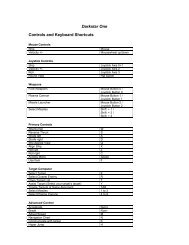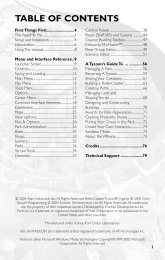Heads-Up Display Modes 35 - Metaboli
Heads-Up Display Modes 35 - Metaboli
Heads-Up Display Modes 35 - Metaboli
Create successful ePaper yourself
Turn your PDF publications into a flip-book with our unique Google optimized e-Paper software.
Air Combat Basics 123<br />
Fight Missiles with Aspect<br />
Most modern missiles fly lead as opposed to pure-pursuit paths to the target. That<br />
means each time the target changes course, the missile changes course as well.<br />
A lead-pursuit missile will attempt to hold a constant lead angle enroute to the<br />
target and appear to remain stable on your canopy relative to the horizon. A purepursuit<br />
missile will appear to remain pointed directly at you, but its position will<br />
drift back toward the back of your aircraft. For the most part, if the missile appears<br />
in a relatively constant position while steadily growing larger, it’s successfully<br />
tracking your aircraft. If the missile appears to be rapidly moving across your<br />
canopy, it’s probably going to miss you (or is tracking somebody else).<br />
hIf a missile appears stationary on the canopy while growing steadily<br />
larger, it is probably on intercept course. If it’s rapidly moving across the<br />
canopy, it probably won’t hit you.<br />
Since missiles, like aircraft, need energy to maneuver and bleed speed while<br />
maneuvering, you want to make the missile maneuver as much as possible. The<br />
more you maneuver, the more work the missile must perform and the more<br />
energy it will bleed trying to adjust to your maneuvers. This forces the missile to<br />
fly a curved path to the target, bleeding speed and energy along the way.<br />
Beaming an Inbound Missile<br />
Begin by “beaming” the target; that is, executing a corner-speed, turn toward the<br />
missile to place it exactly 90° off your nose (to either your 3 o’clock or 9 o’clock<br />
position). Once you have the missile directly on your 3/9 line, pull just enough g-<br />
load to keep it there. The missile has a limited field of view, much like the beam of<br />
light emitted from a flashlight. If you pull a continuous 9 g turn in the middle of<br />
that “beam,” the “flashlight” will fly up and punch a hole through your aircraft.<br />
Instead, you want to fly toward the edge of the beam, known as the gimbal limit<br />
moving as fast as possible across the missile’s field of view. By maneuvering to the<br />
edge of its field of view, you force it to make the largest corrective maneuvers. In<br />
the best case, you might move out of its field of view; in the worst case, you make<br />
the missile bleed as much energy as possible. Keeping the missile directly on the<br />
3/9 line also points your hot engine exhaust away from an IR missile’s seeker.<br />
Beaming may also present problems for Doppler radar systems, although<br />
remember that you’re beaming the missile, not the launching platform.<br />
Like the aforementioned flashlight beam, the missile’s field of view grows wider<br />
at longer range. Consequently, at long range you’ll pull minimum g. As the missile<br />
gets closer, you increase the g-load as necessary to keep it stationary on your 3/9<br />
line. If the missile appears to move toward your nose, you’re pulling too much g<br />
and basically turning inside the missile’s field of view.















